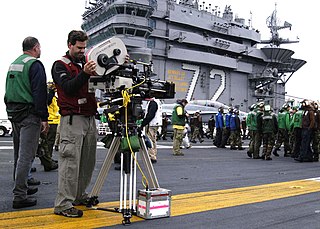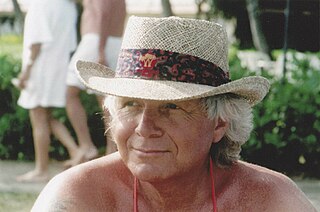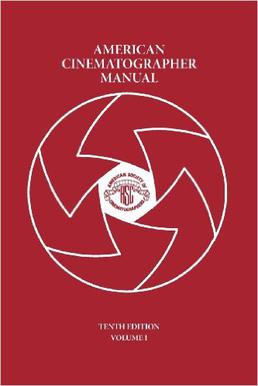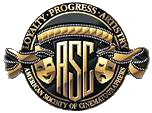
The cinematographer or director of photography is the person responsible for the recording of a film, television production, music video or other live-action piece. The cinematographer is the chief of the camera and light crews working on such projects. They would normally be responsible for making artistic and technical decisions related to the image and for selecting the camera, film stock, lenses, filters, etc. The study and practice of this field are referred to as cinematography.
Roy Henry Wagner III is an American cinematographer known for dramatic, dark imagery. Named by Kodak as one of the "Top 100 Directors of Photography in the World" Wagner's career has spanned 35 years in the motion picture and television industries. He has also received the ASC Award for Outstanding Achievement in Cinematography for a Miniseries, and is a two-time Primetime Emmy Award nominee.
Frederick Elmes, ASC is an American cinematographer, known for his association with the independent film movement. He is a long-time collaborator of directors David Lynch, Ang Lee, Charlie Kaufman, Jim Jarmusch, and Todd Solondz. He has won the Independent Spirit Award for Best Cinematography twice, for Wild at Heart (1990) and Night on Earth (1991), and a Primetime Emmy Award for Outstanding Cinematography for a Limited Series for The Night Of (2016).
Frederick James Koenekamp, A.S.C. was an American cinematographer. He was the son of cinematographer Hans F. Koenekamp.
Russell Paul Carpenter, ASC is an American cinematographer and photographer, known for collaborating with directors James Cameron, Robert Luketic and McG. He won the Academy Award for Best Cinematography for the 1997 Best Picture-winning film Titanic.
Jordan Scott Cronenweth, ASC was an American cinematographer based in Los Angeles, California. A contemporary of Conrad Hall, he was recognized for his distinctive style of heavily textured, film noir-inspired photography, seen in numerous classic films, including Zandy's Bride, Gable and Lombard, Altered States, and Peggy Sue Got Married. He is perhaps best remembered for his BAFTA Award-winning work on the groundbreaking science fiction film Blade Runner, which is credited as codifying the cyberpunk aesthetic, and is lauded by some as among the best cinematographers of all time.
The British Society of Cinematographers is an organisation formed in 1949 by Bert Easey, the then head of the Denham and Pinewood studio camera departments, to represent British cinematographers in the British film industry.

Thomas Del Ruth is a retired American cinematographer.
Dana W. Gonzales is an American director and cinematographer from Los Angeles, California.

The Australian Cinematographers Society (ACS) is a not-for-profit organisation founded in 1958 for the purpose of providing a forum for Australian cinematographers to further develop their skills through mutual co-operation.

Hoyte van Hoytema, ASC, is a Dutch cinematographer who studied at the National Film School in Łódź. His work includes Let the Right One In (2008), The Fighter (2010), Tinker Tailor Soldier Spy (2011), Her (2013), the James Bond film Spectre (2015), Ad Astra (2019), and Nope (2022). Van Hoytema is also known for his collaborations with director Christopher Nolan, having shot Interstellar (2014), Dunkirk (2017), Tenet (2020), and Oppenheimer (2023). His work has been highly praised by film critics and audiences alike and has earned him multiple awards, including one Academy Award nomination and three BAFTA Award nominations for Best Cinematography.
Larry Fong is an American cinematographer born in Los Angeles, California.
Jerzy Karol Zieliński is a Polish cinematographer.
Michael Bradley Barrett is an American cinematographer. He is known for his work on Bobby, Kiss Kiss Bang Bang and Ted.

The American Cinematographer Manual is a filmmaking manual published by the American Society of Cinematographers. Covering lighting, lenses, and film emulsions, it is considered “an authoritative technical reference manual for cinematographers.” The manual also defines the cinematography profession.
James Hawkinson is an American cinematographer known for his work in television, music videos, and film. He is best known for his critically acclaimed work on the Hannibal and The Man in the High Castle television series', for which he has received numerous accolades including a Primetime Emmy Award and a nomination for an ASC Award.

Sharon Calahan is an American cinematographer who was director of photography on the Pixar films A Bug's Life (1998), Toy Story 2 (1999), and Finding Nemo (2003), and was lighting director for Ratatouille (2007), Cars 2 (2011), and The Good Dinosaur (2015). She took part in the early rise of computer animated feature filmmaking and the acceptance of that medium as cinematography. Calahan is the first member of the American Society of Cinematographers who was invited to join on the basis of a career entirely in animated film. She was nominated, with Bill Reeves, Eben Ostby, and Rick Sayre, for a 2000 BAFTA Award for Best Achievement in Special Visual Effects for A Bug's Life.

John Arnold (1889–1964) was an American cinematographer. He began his career in 1914, and in the next 15 years, he shot 86 films. He also worked in film administration, directing the cinematography department at MGM, and was president of the American Society of Cinematographers from 1931 through 1937, and again from 1939 to 1941. By 1938, he was regarded as one of the most authoritative experts on cinematography. He invented several pieces of camera equipment and was awarded two Oscars, both Technical Achievement Awards. The first was in 1938 for improvements on the semi-automatic follow focus device used on motion picture cameras, while the second was in 1940 for the development of the MGM mobile camera crane.
Cynthia Pusheck is an American film and television cinematographer. She co-founded and co-chairs the ASC Vision committee that supports people from under-represented groups who hope to build a career in cinematography. She was the first woman to serve as Vice-President of the American Society of Cinematographers (ASC).







